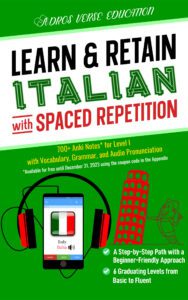There are six vowels in Arabic: three long vowels and three short vowels. In this lesson, we cover Arabic vowels in details.
Table of Contents
- Role of Consonants vs. Vowels
- Long Vowels in Arabic
- Short Vowels in Arabic
- Effect of Preceding Sound on Vowels
- Diphthongs in Arabic
- سُـكـون (Sukūn)
- Level I – Beginner I (A1)
Role of Consonants vs. Vowels
The abjad writing system represents consonants. In Arabic and Semitic languages in general, consonants are the primary carriers of meaning, while vowels play other important roles, such as forming verbs, nouns, plurals, and other derivatives from the consonantal root.
There are six vowels in Arabic: three long vowels and three short vowels.
Long Vowels in Arabic
Remember that the abjad letters are all consonants. To form the long vowels, we reuse the three consonants ﺍ (’), ﻮ (w), and ﻱ (y). When adapted as long vowels, these letters are pronounced as: ﺍ (ā), ﻮ (ū), and ﻱ (ī). Let us apply the three long vowels to the consonant ب (b):
| Letter | Romanized | Vowel | Description of the Vowel Sound |
| بـا | bā | ﺍ (ā) | بـا (bā) sounds like “ba” in “bat.” |
| بـو | bū | ﻮ (ū) | بـو (bū) sounds like “boo” in “boot.” |
| بـي | bī | ﻱ (ī) | بـي (bī) sounds like “bee” in “beet.” |
A long vowel is also known as مَـدّ (madd) in Arabic. The name of each مَـدّ (madd) is as follows:
- ﺍ (ā) is called مَـدّ أَلِـف (madd ’alif), i.e., ‘long ā’ vowel.
- ﻮ (ū) is called مَـدّ واو (madd wāw), i.e., ‘long ū’ vowel.
- ﻱ (ī) is called مَـدّ يـاء (madd yā’), i.e., ‘long ī’ vowel.
Short Vowels in Arabic
On the other hand, short vowels are often not written in most Arabic texts but are inferred from context. Nevertheless, as students begin learning Arabic, short vowels are used until new words become familiar. Short vowels are denoted by diacritics called حَـرَكَـات (ḥarakāt), with the singular form being حَـرَكَـة (ḥarakah), written above or below consonants. The process of adding these حَـرَكَـات (ḥarakāt) is called تَـشْـكِـيـل (tash kīl). Let us apply the three short vowels to the consonant ب (bā’) ‘b’:
| Letter | Romanized | Vowel | Description of the Vowel Sound |
| بَ | ba | ـﹷـ (a) | بَ (ba) sounds like “be” in “bet,”or short “ba” in “bat.” |
| بُ | bu | ـﹹـ (u) | بُ (bu) sounds like “bu” in “bull.” |
| بِ | bi | ـﹻـ (i) | بِ (bi) sounds like “bi” in “bit.” |
Let us compare long and short vowels side by side, applied to the consonant ب (bā’) ‘b’:
| Short | Romanized | EN Example | Long | Romanized | EN Example |
| بَ | ba | like “bet” | بـا | bā | like “bat” |
| بُ | bu | like “bull” | بـو | bū | like “boot” |
| بِ | bi | like “bit” | بـي | bī | like “beet” |
The name of each حَـرَكَـة (ḥarakah) in Arabic is as follows:
- ـﹷـ is called فَـتْـحَـة (fatḥah), representing a ‘short a.’
- ـﹹـ is called ضَـمَّـة (ḍammah), representing a ‘short u.’
- ـﹻـ is called كَـسْـرَة (kasrah), representing a ‘short i.’
| Notice that many letters are distinguished by the number of dots and their placement relative to the letter, e.g., ب (b), ت (t), and ث (th). Historically, not only were vowels not written, but even the dots used to distinguish the letters were also omitted in early Arabic writing. The reader was expected to guess the letter based on context. For instance, ٮـٮـٮ could be read as بَـيْـت (bayt) ‘house,’ بِـنْـت (bint) ‘girl,’ ثَـبَـتَ (thabata) ‘he stood still,’ or any other meaningful combination. Only context could help determine the correct word. |
Effect of Preceding Sound on Vowels
The quality of the ‘short a’ and ‘long ā’ vowels in Arabic is affected by the preceding sound. For example, if the preceding consonant is emphatic, the ‘short a’ and ‘long ā’ vowels tend to sound more retracted. In other words, the ‘short a’ sounds like the “u” in “but,” rather than the “e” in “bet.” On the other hand, the ‘long ā’ sounds like the “a” in “father,” rather than the “a” in “cat,” when following an emphatic sound.
| Following an emphatic sound Short ‘a’ sounds like ‘u’ in ‘but’ Long ‘ā’ sounds like ‘a’ in ‘father’ | Following an unemphatic sound Short ‘a’ sounds like ‘e’ in ‘bet’ Long ‘ā’ sounds like ‘a’ in ‘bat’ | ||
| ص (ṣ) | صَـحـيـح (ṣaḥīḥ) ‘correct’ | س (s) | سَـعـيـد (sa‘īd) ‘happy’ |
| ض (ḍ) | ضـالّ (ḍāll) ‘stray’ | د (d) | دافِـئ (dāfi’) ‘warm’ |
| ط (ṭ) | طـالِـب (ṭālib) ‘student’ | ت (t) | تـاريـخ (tārīkh) ‘history’ |
| ظ (ẓ) | ظَـهْـر (ẓahr) ‘back’ | ذ (dh) | ذَكِـيّ (dhakiyy) ‘smart’ |
This also applies to the sounds ق (qāf) ‘q’ and ك (kāf) ‘k’:
| Following ق (qāf) ‘q’ Short ‘a’ sounds like ‘u’ in ‘but’ Long ‘ā’ sounds like ‘a’ in ‘father’ | Following ك (kāf) ‘k’ Short ‘a’ sounds like ‘e’ in ‘bet’ Long ‘ā’ sounds like ‘a’ in ‘bat’ | ||
| ق (q) | قَـلْـب (qalb) ‘heart’ | ك (k) | كَـلْـب (kalb) ‘dog’ |
| قـاتِـل (qātil) ‘killer’ | كـاتِـب (kātib) ‘writer’ | ||
In general, the sounds خ (khā’) ‘kh’ and غ (ghayn) ‘gh’ cause the ‘short a’ and ‘long ā’ vowels to be more retracted. However, this varies based on regional differences.
Diphthongs in Arabic
The ‘short a’ vowel in Arabic, known as فَـتْـحَـة (fatḥah), can be followed by “w” or “y” to create the two sounds “aw” and “ay,” pronounced like shorter versions of the “ow” in “how” and “y” in “fly,” respectively. Even though these are called diphthongs in grammar, from an Arabic grammarian’s point of view, the “w” and “y” in the “aw” and “ay” sounds, respectively, are considered consonants.
It is common in Arabic dialects to pronounce “aw” and “ay” like “o” in “home” and “ai” in “jail,” respectively. For example:
| MSA | Most Dialects | MSA | Most Dialects |
| يَــوْم yawm day | يــوم yoʊm day | الـكُـوَيْـت al-kuwayt Kuwait | الـكُـويـت al-kuwait Kuwait |
| الـكَـوْن al-kawn the universe | الـكـون al-koʊn the universe | غَـيْـمَـة ghaymah a cloud | غـيـمَـة ghaimah a cloud |
Remember that the letters و ‘w’ and ي ‘y’ are considered long vowels only when used to produce the sounds “ū” and “ī,” respectively. We will follow this convention here and assert that the Arabic language has only six vowels: three short vowels and three long vowels.
سُـكـون (Sukūn)
If a consonant is not followed by a short vowel in Arabic, the proper diacritic to be added is called سُـكـون (sukūn), denoted by a small circle ــﹿــ above the letter.
The word سُـكـون (sukūn) means “rest” or “stillness,” referring to the absence of a short vowel after the consonant.
Consider the English word “Muslim.” In Arabic, it is often written as مـسـلـم, which is equivalent to writing the word in English without its vowels, i.e., “Mslm.” Remember that Arabic is written from right to left.
Without vocalization, we spell out the word مـسـلـم (mslm) as follows:
| (1) | (2) | (3) | (4) |
| m | s | l | m |
| (4) | (3) | (2) | (1) |
| ـم | ـلـ | ـسـ | مـ |
We add the vowels to the consonants in the following way:
- After the first “m,” we add a ‘short u’ vowel, represented by ـﹹـ on مـ in Arabic, i.e., مُـ.
- After “l,” we add a ‘short i’ vowel, represented by ـﹻـ on ـلـ in Arabic, i.e., لِــ.
- The consonants “s” and the second “m,” which are not followed by a vowel sound, are denoted in Arabic by a سُـكـون (sukūn) ــﹿــ above each consonant, i.e., ـسْـ and ـمْ.
The resulting vocalized word is: مُــسْــلِــمْ (muslim).
| (1) | (2) | (3) | (4) |
| mu | s | li | m |
| (4) | (3) | (2) | (1) |
| ـمْ | ـلِـ | ـسْـ | مُـ |
Here are some additional examples:
| Without Diacritics | With Diacritics | |||
| EN | AR | Romanized | AR | Romanized |
| Ahmad | أحـمـد | ’ḥmd | أَحْـمَـد | ’aḥmad |
| house | مـنـزل | mnzl | مَـنْـزِل | manzil |
| crocodile | تـمـسـاح | tmsāḥ | تِـمْـسـاح | timsāḥ |
| burned | مـحـتـرق | mḥtrq | مُـحْـتَـرِق | muḥtariq |
Note that we write long vowels even when diacritics are omitted, e.g., ﺍ (ā) in تـمـسـاح (tmsāḥ) ‘crocodile.’
Remember that the سُـكـون (sukūn) indicates that the letter is not followed by a short vowel sound. When ﺍ ‘ā,’ ﻮ ‘ū,’ and ﻱ ‘ī’ are used as long vowels, they may also be marked with سُـكـون (sukūn) because a long vowel is always followed by a consonant and never by a short vowel. Therefore, the consonant preceding the long vowel can be marked with a short vowel, and the long vowel can be marked with سُـكـون (sukūn). However, it is common to omit the سُـكـون (sukūn) on the long vowel because it is implicitly understood. Some people also omit the short vowel on the consonant preceding the long vowel.
Let us apply these vocalization methods to the following syllables formed with the consonant ب (bā’) ‘b’ and a long vowel:
| Vocalization #1 | Vocalization #2 | Vocalization #3 | |
| bā | بَــاْ | بَــا | بــا |
| bū | بُــوْ | بُــو | بــو |
| bī | بِــيْ | بِــي | بــي |
Throughout the lessons, we use the third vocalization convention, but it is useful to be aware of the other two.
Next: Stressed Consonants in Arabic
Back to: Cursive Features of Arabic Letters
Other lessons in Level I:









